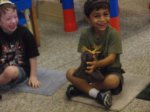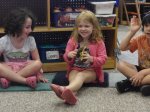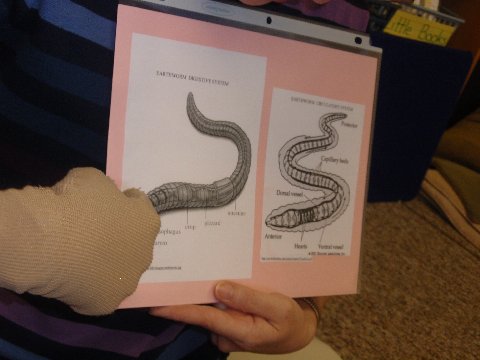Hi –
This week, with Rosh Hashanah just around the corner, everyone is learning about apples. When I think of apples and Science, I think of worms! Who hasn’t seen a picture like this one?:
So, I started thinking about apples and worms and wondering about how the worms get into the apples if they don’t have any teeth. It turns out that they don’t. Worm-y apples are actually caterpillar-y apples. The Codling Moth lays its eggs on or near developing fruit. When the larvae hatch, the caterpillars tunnel to the center of the fruit and they remain there until they have fully developed. Then, they exit the fruit, pupate, and turn into moths.
What do worms have to do with apples? Not much. Except that they’ll eat pieces of apple in a compost pile. Nevertheless, today we learned all about worms.
The first thing we did was to meet a large, pink worm:
The class did not believe that it was real – imagine that.
The worm was hungry, so it wiggled up out of the ground,
where it found a leaf.
The worm pushed its throat out of its mouth in order to grab the food.
Then it brought the leaf back down under the ground.
Worms don’t have teeth – which makes it difficult to chew food.
Instead, a worm has a gizzard.
Worms swallow small rocks that they store in their gizzards.
Here are the rocks:
Here are the rocks being stored in the ‘gizzard.’
Here is a leaf that the worm wants to eat.
The leaf went into the gizzard, and the gizzard was passed around to everyone.
A worm’s gizzard is surrounded by very strong muscles.
By contracting its muscles, the worm uses the rocks to grind up its food:
- 20110913 08554720worms20 20jen2020merav 017
- 20110913 08563220worms20 20jen2020merav 023
- 20110913 08555720worms20 20jen2020merav 018
- 20110913 08570620worms20 20jen2020merav 026
- 20110913 08572420worms20 20jen2020merav 028
- 20110913 08561620worms20 20jen2020merav 021
- 20110913 08552920worms20 20jen2020merav 015
- 20110913 08565220worms20 20jen2020merav 024
- 20110913 08560420worms20 20jen2020merav 019
- 20110913 08553820worms20 20jen2020merav 016
- 20110913 08562520worms20 20jen2020merav 022
After everyone had a chance to squeeze the bag, this was the
biggest piece of leaf that we could find inside:
We looked at a few diagrams of a worm’s insides:
then out came the real Guest Worms:
While we were a bit hesitant at first,
we all became friends in short order.
We did a few worm experiments.
Which do worms like better – a dry surface or a wet surface?
dry side
wet side
Apparently, the worms were not too picky:
Then, we passed around a piece of sandpaper:
Which would the worms like better?
The worms appeared to favor the sandpaper.
Perhaps it was easier to move across a rough surface (better traction).
Finally, we all had a chance to look at / touch / hold a worm (if we were so inclined):
- 20110913 09212920worms20 20jen2020merav 057
- 20110913 09221820worms20 20jen2020merav 059
- 20110913 09260920worms20 20jen2020merav 067
- 20110913 09233620worms20 20jen2020merav 063
- 20110913 09215420worms20 20jen2020merav 058
- 20110913 09194120worms20 20jen2020merav 053
- 20110913 09231720worms20 20jen2020merav 062
- 20110913 09205420worms20 20jen2020merav 056
- 20110913 09202320worms20 20jen2020merav 055
- 20110913 09223020worms20 20jen2020merav 060
- 20110913 09225420worms20 20jen2020merav 061
The worm that we held twisted into all sorts of shapes.
We talked about how we could probably have the worms form every letter of the alphabet.
I went through all of my worm photos from today and came up with the following:
Not bad, for a worm!
See you next week,
Morah Elaine









































